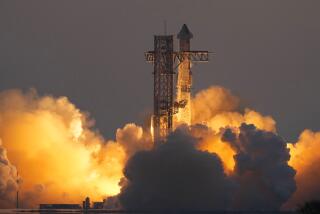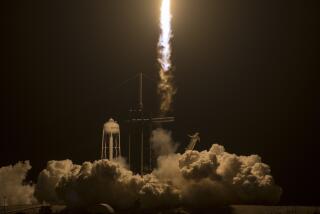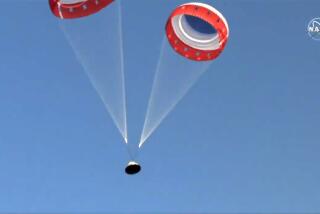Maverick Satellite Still Eludes Lasso by Shuttle : Space: Target foils astronauts from Endeavour a second time. Crew makes plans to try rescue again.
- Share via
HOUSTON — The crew of space shuttle Endeavour on Monday failed to recapture a stranded communications satellite that earlier had spun out of their reach, and made plans to try again today or Wednesday.
Extended into space while lashed to a small platform on the shuttle’s 50-foot robot arm, Navy Cmdr. Pierre J. Thuot came excruciatingly close to snagging the 17-foot, 8,960-pound Intelsat 6 at 4:18 p.m. PDT.
As Thuot gently placed a 15-foot “capture bar” against the bottom of the slowly spinning satellite, astronaut Bruce E. Melnick, working in the open cargo bay, exclaimed, “I do believe . . . “
But then the satellite slowly twisted away, apparently because two latches at the ends of the capture bar failed to fire.
“You were right in there,” one of the seven disappointed crew members told Thuot as he watched the satellite inch away.
“I held it up there firm,” Thuot said. “That’s what happened, the latches didn’t fire.”
After the failure, the second in two days, Melnick pulled Thuot back toward the cargo bay. He later made another attempt at grabbing the satellite, but failed again.
The rescue attempt followed Sunday’s disappointing failure, when Thuot sent the Intelsat 6 tumbling when he touched it with the bar.
Officials of the National Aeronautics and Space Administration said Monday that the Sunday mishap occurred largely because the ground-based simulator that Thuot trained on for a year did not adequately mirror the sensitivity of the orbiting satellite.
As a result, NASA officials said that Thuot, instead of applying the planned 10 pounds of force on the satellite, actually used 90 pounds as he attempted to snag it and grapple it into the shuttle’s cargo bay.
“The system just proved to be a little more sensitive, or maybe a lot more sensitive . . . than we predicted,” said Randy Stone, NASA mission operations director. “Nobody screwed up. Nobody did anything wrong.”
Flight controllers at Intelsat’s Washington headquarters fired the satellite’s small rocket motors to halt its tumbling. They also used smaller thrusters to increase the satellite’s spin, which enhances its stability.
By early Monday, the satellite was again stable and ready for a second rendezvous with the Endeavour, an Intelsat spokesman said. The goal was to capture the satellite, clamp it to a new, 23,000-pound, solid-fuel rocket motor, and rocket it into its proper orbit.
A successful rescue of the Intelsat 6 would mark the first time that astronauts had saved a satellite by delivering a new rocket motor and attaching it in space.
At 2 p.m. PDT, flying 225 miles over Australia, the Endeavour began closing in for its final approach to the satellite, which was less than two miles away and traveling at a speed of 17,500 miles an hour.
Seven minutes later, Thuot and astronaut Richard J. Hieb, 36, left the shuttle’s air lock and entered the spacecraft’s open cargo bay. Thuot began preparing for a planned practice session with the “capture bar”’ before attempting to snag the satellite.
Meanwhile, Endeavour commander Daniel C. Brandenstein, working from the shuttle’s aft cockpit, took manual control of the spacecraft as the shuttle was abreast of the satellite, flying about 2,500 feet below the target.
Brandenstein slowly pulled the shuttle up in front of the satellite, with the shuttle’s tail pointed toward the Earth. Astronaut Kathryn C. Thornton, 39, used a laser gun to measure the distance between the shuttle and the satellite.
The maneuver aligned the open shuttle cargo bay with the bottom of the Intelsat 6.
As the shuttle pulled into position, Thuot attached a small platform to the shuttle’s movable robot arm, and stepped into a pair of stirrups on the platform. Lashed to the platform, Thuot picked up the capture bar, and began the practice session. Hanging upside down over the cargo bay, Thuot gently bumped the bar along one of the handrails at the edge of the shuttle’s 60-foot-long cargo bay. The purpose of the session was for Thuot to get a better feel of how much force would be required to capture the satellite.
Brandenstein, meanwhile, continued to fly the shuttle in a mini-orbit, up and over the satellite, killing time until Endeavour and the Intelsat 6 emerged from the Earth’s shadow into daylight.
At 3:52, PDT Melnick told Thuot: “Okay, here we go.”
During the next 26 minutes, Melnick made five attempts to place Thuot at the center of the satellite’s undercarriage, which resembles a 12-foot-wide, rotating tin can.
He came close several times, but was thwarted by a slight wobble in the satellite, or by the proximity of the capture bar to the satellite’s small rocket motors.
Thuot was to grab the bottom of the satellite. Then, gripping a wheel built into the bar, he was to slow, and finally stop, the satellite’s spin, and then hook the bar--and the satellite--onto the shuttle’s robot arm.
Melnick was to then pull Thuot and the satellite back into the shuttle bay. There, Thuot was to unstrap himself from the arm. Then, Thuot and Hieb were to hitch the satellite to four docking clamps on the frame that houses the new rocket motor.
After the two crew members attached electric umbilical cords linking the motor to the satellite, they were to set four pre-loaded springs designed to push the satellite and rocket back into space.
Once the spacewalkers were safely inside, the crew was to release the springs, and send the satellite assembly spinning away from the shuttle at a speed of about half a foot per second.
Intelsat controllers were to have fired the rocket motor today. The rocket would initially propel the satellite into an elliptical orbit that would bring it as far as 51,750 miles away from Earth. Eventually, the satellite is to settle into a geosynchronous orbit over the Atlantic Ocean.
From a geosynchronous orbit, the Intelsat 6 can simultaneously carry 120,000 telephone circuits and three television channels and is expected to generate more than $750 million in revenues for Intelsat over its 10-year life.
The satellite, which is to beam video of the 1992 Summer Olympics around the world, was stranded in a useless, low-Earth orbit in March, 1990, when the commercial Titan rocket that carried it aloft malfunctioned. Intelsat paid NASA $93 million for the rescue mission, and another $50 million to the Hughes Aircraft Co. for the new rocket motor.
More to Read
Sign up for Essential California
The most important California stories and recommendations in your inbox every morning.
You may occasionally receive promotional content from the Los Angeles Times.










